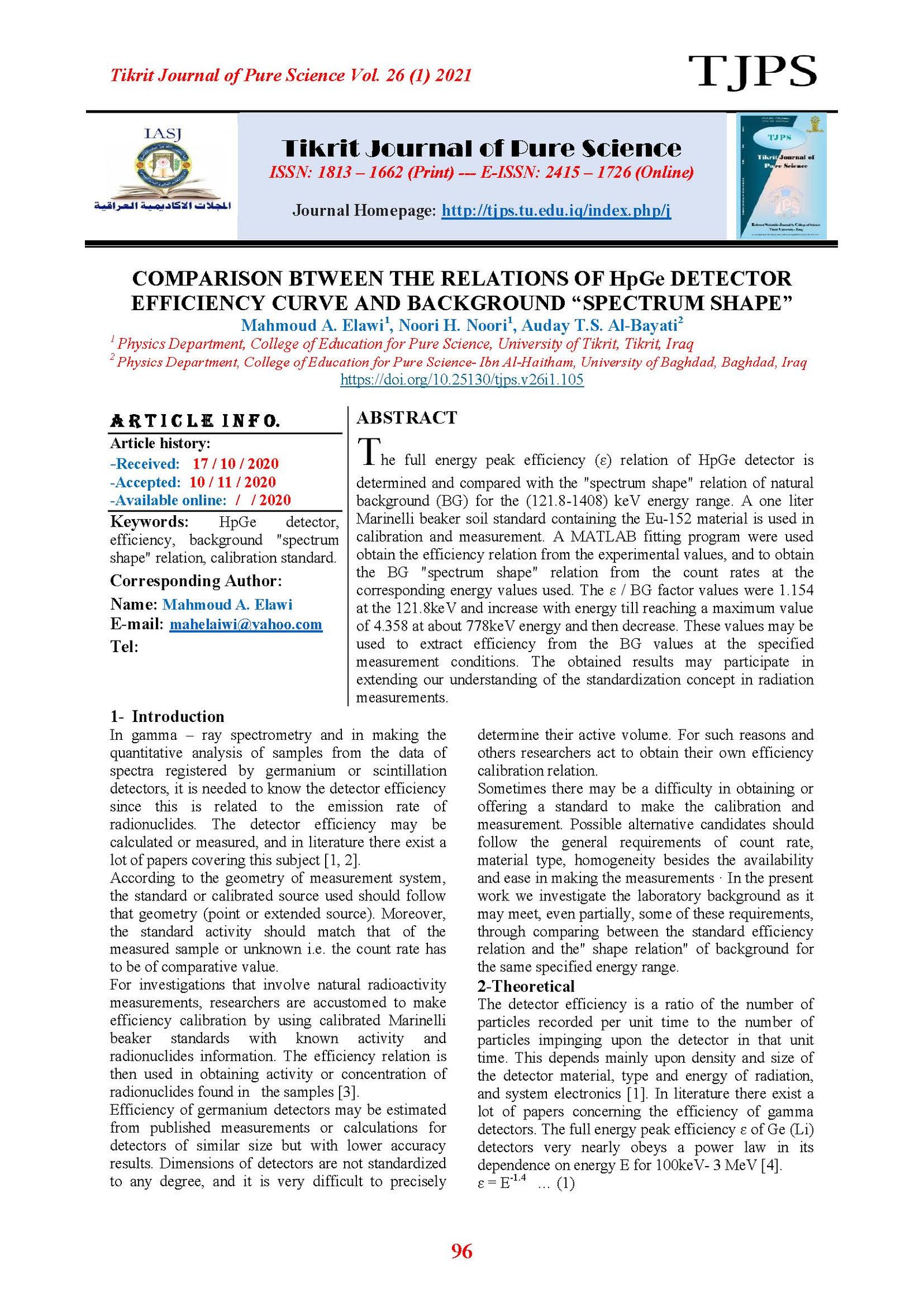COMPARISON BTWEEN THE RELATIONS OF HpGe DETECTOR EFFICIENCY CURVE AND BACKGROUND “SPECTRUM SHAPE”
Main Article Content
Abstract
The full energy peak efficiency (ɛ) relation of HpGe detector is determined and compared with the "spectrum shape" relation of natural background (BG) for the (121.8-1408) keV energy range. A one liter Marinelli beaker soil standard containing the Eu-152 material is used in calibration and measurement. A MATLAB fitting program were used obtain the efficiency relation from the experimental values, and to obtain the BG "spectrum shape" relation from the count rates at the corresponding energy values used. The ɛ / BG factor values were 1.154 at the 121.8keV and increase with energy till reaching a maximum value of 4.358 at about 778keV energy and then decrease. These values may be used to extract efficiency from the BG values at the specified measurement conditions. The obtained results may participate in extending our understanding of the standardization concept in radiation measurements.
Article Details

This work is licensed under a Creative Commons Attribution 4.0 International License.
Tikrit Journal of Pure Science is licensed under the Creative Commons Attribution 4.0 International License, which allows users to copy, create extracts, abstracts, and new works from the article, alter and revise the article, and make commercial use of the article (including reuse and/or resale of the article by commercial entities), provided the user gives appropriate credit (with a link to the formal publication through the relevant DOI), provides a link to the license, indicates if changes were made, and the licensor is not represented as endorsing the use made of the work. The authors hold the copyright for their published work on the Tikrit J. Pure Sci. website, while Tikrit J. Pure Sci. is responsible for appreciate citation of their work, which is released under CC-BY-4.0, enabling the unrestricted use, distribution, and reproduction of an article in any medium, provided that the original work is properly cited.
References
[1] Tsoulfanidis, N. (1995), Measurement and Detection of Radiation. 2nd edn. Taylor and Francis.
[2] Knoll, G.F., (2000), Radiation Detection and Measurement. 3rd edn. John Wiley & Sons, Inc. New Jersey, USA.
[3] AL-Saudany, Z.A.I., (2016), Natural and Artificial radionuclide concentrations for different environmental samples in AL-Amara city, Missan governorate. Ph.D. Thesis, College of Science for Women, Baghdad University.
[4] Adams, F., and Dams, R. (1975), Applied gamma-ray spectroscopy. Pergamum press, Oxford.
[5] Kane, W.R., and Mari scotti, M.A., (1967).Nucl. Instr. and Meth., 56.
[6] Freeman, J.M., and Jenkin, J.G. (1966). Nucl. Instr. and Meth., 43.
[7] East, L.V., (1971). Nucl. Instr. and Meth., 93.
[8] McNelles, L.A., and Campbell, J.L., (1973). Nucl. Instr. and Meth., 109.
[9] Al-Bayati, A.T.S., (2017). Determination of the concentrations for radioactive elements around AL-Tuwaitha center using gamma-ray spectroscopy and CR-39 detectors. Ph.D. Thesis, college of education for pure science, university of Baghdad.
